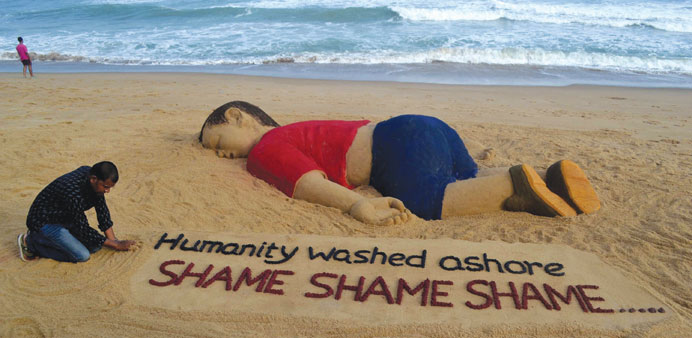Indian artist Sudarsan Pattnaik working on a sand sculpture depicting drowned Syrian boy Aylan Kurdi at Puri beach, some 65km away from Bhubaneswar, yesterday.
By Guy Jackson and Herve Bar
AFP/Paris
The small Syrian boy’s lifeless body on a Turkish beach has fast become one of the defining images of the migrant crisis in Europe and seems to be shifting public opinion.
The photograph of Aylan Kurdi spread rapidly on social media and made the front pages of newspapers across world on Thursday, bringing home the human tragedy of a story that has been running for months.
Some commentators said its impact was comparable to the iconic shot of a naked girl running towards the camera from a napalm attack during the Vietnam War.
French newspapers were the exception to the rule as Le Monde was the only daily to feature the photograph on its front page, but politicians felt its impact immediately.
Prime Minister Manuel Valls tweeted: “He had a name - Aylan Kurdi. It is urgent that we act, that Europe mobilises itself.”
Within hours, France and Germany - after weeks of hesitation - agreed on Thursday that the European Union should impose binding quotas on the numbers of migrants that member states accept.
In Britain, Prime Minister David Cameron said he felt “deeply moved” by the picture, but came under renewed attack for failing to agree to accept a greater share of Syrian refugees.
Twenty-four hours later, with public pressure building and hundreds of thousands of people adding their names to a petition urging him to act, Cameron announced that Britain “will welcome thousands more Syrian refugees”.
Roy Greenslade, a former editor of British tabloid The Daily Mirror and now a media commentator for The Guardian, said he saw a clear shift in the way newspapers used the photograph on Thursday.
It was “such a shocking image that even those editors who have run anti-refugee propaganda for week upon week felt they must give it full measure”, he wrote.
But he added: “A quick scan of the other headlines and articles about the refugee crisis suggest that it is business as usual for most editors”.
“There was a clear message: Britain is right to refuse to take in more refugees,” he said.
Editorials in many papers suggested the photo was a significant turning point, with The Times identifying a “tardy wave of public anger at Britain’s perceived bystander status”.
“Now and again, there are things that trigger public opinion and make things move,” said Bruno Jeambart, from the OpinionWay polling institute in France.
“Without a doubt, (the photographs of Aylan) has already had an impact on a political level.”
In France, he noted, “until now the discussion has been quite unreceptive to taking in migrants, especially on the political right”.
“(The photographs) could influence and change political positions,” he added.
In Rome, the charity Migrant Offshore Aid Station, which organises rescues in the Mediterranean, said yesterday that it had received a record 600,000 euros in donations since the photograph’s publication.
“There is an enormous response from the public, the tide of indifference is shifting,” said a spokesperson for the agency.
Other commentators cautioned that one picture could not change public opinion overnight.
“It would be astonishing if one picture, as harrowing as it is, completely changes the perception of migrants,” said Gael Sliman, head of the French-based Odoxa polling institute.

